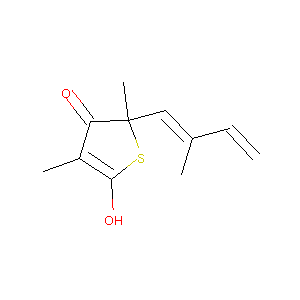| DOT Name |
DOT ID |
UniProt ID |
Mode of Action |
REF |
|
Inhibitor of nuclear factor kappa-B kinase subunit alpha (CHUK)
|
OTLF4ZB1
|
IKKA_HUMAN
|
Increases Phosphorylation
|
[7] |
|
Cellular tumor antigen p53 (TP53)
|
OTIE1VH3
|
P53_HUMAN
|
Increases Expression
|
[7] |
|
Cyclin-dependent kinase 1 (CDK1)
|
OTW1SC2N
|
CDK1_HUMAN
|
Increases Expression
|
[8] |
|
Apoptosis regulator Bcl-2 (BCL2)
|
OT9DVHC0
|
BCL2_HUMAN
|
Decreases Expression
|
[9] |
|
G2/mitotic-specific cyclin-B1 (CCNB1)
|
OT19S7E5
|
CCNB1_HUMAN
|
Decreases Expression
|
[8] |
|
Cyclin-A2 (CCNA2)
|
OTPHHYZJ
|
CCNA2_HUMAN
|
Decreases Expression
|
[8] |
|
G1/S-specific cyclin-E1 (CCNE1)
|
OTLD7UID
|
CCNE1_HUMAN
|
Increases Expression
|
[8] |
|
Cyclin-dependent kinase 2 (CDK2)
|
OTB5DYYZ
|
CDK2_HUMAN
|
Increases Expression
|
[8] |
|
Mitogen-activated protein kinase 3 (MAPK3)
|
OTCYKGKO
|
MK03_HUMAN
|
Decreases Phosphorylation
|
[8] |
|
Mitogen-activated protein kinase 1 (MAPK1)
|
OTH85PI5
|
MK01_HUMAN
|
Decreases Phosphorylation
|
[8] |
|
Hematopoietic progenitor cell antigen CD34 (CD34)
|
OT1MOFLZ
|
CD34_HUMAN
|
Decreases Expression
|
[7] |
|
ADP-ribosyl cyclase/cyclic ADP-ribose hydrolase 1 (CD38)
|
OTG0TTX7
|
CD38_HUMAN
|
Increases Expression
|
[7] |
|
RAC-alpha serine/threonine-protein kinase (AKT1)
|
OT8H2YY7
|
AKT1_HUMAN
|
Decreases Phosphorylation
|
[8] |
|
Phosphatidylinositol 4,5-bisphosphate 3-kinase catalytic subunit alpha isoform (PIK3CA)
|
OTTOMI8J
|
PK3CA_HUMAN
|
Decreases Expression
|
[8] |
|
Serine/threonine-protein kinase mTOR (MTOR)
|
OTHH8KU7
|
MTOR_HUMAN
|
Decreases Phosphorylation
|
[8] |
|
Caspase-3 (CASP3)
|
OTIJRBE7
|
CASP3_HUMAN
|
Increases Cleavage
|
[8] |
|
Proliferation marker protein Ki-67 (MKI67)
|
OTA8N1QI
|
KI67_HUMAN
|
Decreases Expression
|
[8] |
|
Neurogenic locus notch homolog protein 1 (NOTCH1)
|
OTI1WADQ
|
NOTC1_HUMAN
|
Increases Expression
|
[7] |
|
Ephrin type-B receptor 4 (EPHB4)
|
OTKLPVXJ
|
EPHB4_HUMAN
|
Decreases Expression
|
[8] |
|
Caspase-7 (CASP7)
|
OTAPJ040
|
CASP7_HUMAN
|
Increases Cleavage
|
[8] |
|
Caspase-9 (CASP9)
|
OTD4RFFG
|
CASP9_HUMAN
|
Increases Cleavage
|
[8] |
|
Phosphatidylinositol 3,4,5-trisphosphate 3-phosphatase and dual-specificity protein phosphatase PTEN (PTEN)
|
OTOWDUNT
|
PTEN_HUMAN
|
Increases Expression
|
[8] |
|
Nuclear factor NF-kappa-B p100 subunit (NFKB2)
|
OTS231V7
|
NFKB2_HUMAN
|
Increases Expression
|
[7] |
|
Transcription factor RelB (RELB)
|
OTU3QYEF
|
RELB_HUMAN
|
Increases Expression
|
[7] |
|
Transcription factor p65 (RELA)
|
OTUJP9CN
|
TF65_HUMAN
|
Increases Expression
|
[7] |
|
Apoptosis regulator BAX (BAX)
|
OTAW0V4V
|
BAX_HUMAN
|
Increases Expression
|
[8] |
|
Induced myeloid leukemia cell differentiation protein Mcl-1 (MCL1)
|
OT2YYI1A
|
MCL1_HUMAN
|
Decreases Expression
|
[9] |
|
Jouberin (AHI1)
|
OT8K2YWY
|
AHI1_HUMAN
|
Increases Expression
|
[10] |
|
Bcl2-associated agonist of cell death (BAD)
|
OT63ERYM
|
BAD_HUMAN
|
Increases Expression
|
[8] |
| ------------------------------------------------------------------------------------ |
|
|
|
|


